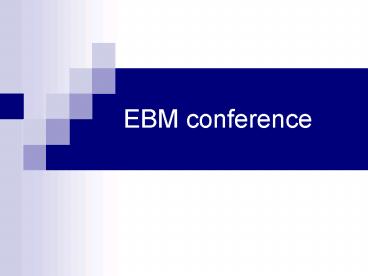EBM conference - PowerPoint PPT Presentation
1 / 36
Title: EBM conference
1
EBM conference
2
PICO
- PPatient with sinusitis
- I nasal irrigation
- C medicine or other medication
- O Outcome (symptom relief, quality of life)
3
Key word
- Sinusitis
- Nasal irrigation
4
Background
- Chronic rhinosinusitis (CRS) is a common disorder
with a significant impact on the quality of life
and health burden within the adult population
(Gliklich 1995). - Chronic rhinosinusitis is thought to affect
between 5 and 15 of the population (Melen
1994). - The diagnosis of rhinosinusitis is based on
sino-nasal symptoms - Present for 12 weeks or more ?chronic
5
Medical treatment
- Short and longterm antibiotic therapy
- Topical and systemic steroids
- Topical and oral decongestants
- Oral antihistamines
- Mast cell stabilisers
- Phytotherapy
- Avoidance of environmental factors
- Antileukotriene agents
- Mucolytics,
- Topical antibiotics
- Topical and systemic
- antimycotics
- Proton pump inhibitors
- Bacterial lysates
- Immunotherapy
6
Background
- Saline irrigations and sprays are, however,
frequently regarded as a homeopathic adjunct in
the treatment of sino-nasal disease. - The nature of the benefit of saline is difficult
to define physiologically. - The mechanical clearance of mucus is commonly
proposed as the sole basis of its benefit.
7
Benefit
- Improvement inmucus clearance
- Enhanced ciliary beat activity
- Removal of antigen
- Biofilm or inflammatory mediators
- Protective role on sino-nasal mucosa
8
Background
- Allergic rhinitis (IRMWS 1994)
- Pregnancy rhinitis (Ellegard 2006)
- Paediatric chronic sinusitis (Muntz 2004)
- Primary care recommendations (Seaton 1998)
- Sinonasal sarcoid (Long 2001)
- Wegeners granulomatosis (Tami 2005)
- Chronic rhinosinusitis (EPOS 2005)
- Post-operative care (Seppey 1996)
- Decontamination of radioactive material (Berger
2003) - Topical saline preparations vary from commercial
single use
9
Background
- The direct clinical effectiveness of saline in
treatment protocols is not clear. - The primary focus of the review is symptom
relief.
10
Types of studies
- Randomised controlled trials which fulfil the
criteria outlined below. - Controlled clinical trials were also identified
by the search.
11
Types of participants
- Rhinitis with seasonal exacerbations
- Perennial rhinitis
- Recurrent acute sinusitis in patients with
ongoing symptoms between exacerbations and
chronic rhinosinusitis
12
Types of intervention
- Saline versus no saline
- Saline versus placebo
- Standard therapy with saline versus standard
therapy alone - Saline alone versus active agent
- Hypertonic versus isotonic saline
13
Placebo
- The placebo for nasal saline irrigation
encompassed any intervention which has no known
biological activity but provides a similar level
of interaction within the setting of chronic
disease. - The aim of placebo in this setting is to reduce
the maintenance and performance bias of patients
within trials. - It is acknowledged that blinding the patients to
nasal irrigation is extremely difficult.
14
Primary outcomes
- Validated quality of life measures, both generic
and disease specific - Symptom scores
- (visual analogue scores or Likert scores)
15
Secondary outcomes
- Adverse events
- Radiological scores (Lund and Mackay CT scores)
- Endoscopic scores (Lund or EPOS)
16
DESCRIPTION OF STUDIES
- The remaining eight trials satisfied the
inclusion criteria
17
(No Transcript)
18
Five types
- A Comparison of saline versus no treatment
- B Comparison of saline versus placebo
- C Standard therapy with saline versus standard
therapy alone - D Saline alone versus active agent
- E Hypertonic versus isotonic saline
19
Results
- A Comparison of saline versus no treatment
- ?Saline better than no treatment for improving
- symptoms and disease specific quality of life
- scores.
20
(No Transcript)
21
(No Transcript)
22
(No Transcript)
23
Results
- B Comparison of saline versus placebo
- ?Saline did not improve disease specific quality
of life scores over a reflexology control.
24
(No Transcript)
25
(No Transcript)
26
Results
- C Standard therapy with saline versus standard
therapy alone - ?Saline improves disease specific quality of life
scores as an addition to oral antihistamine
therapy.
27
Results
- D Saline alone versus active agent
- ?Isotonic or hypertonic saline did not improve
disease specific quality of life scores over
intra-nasal steroid
28
(No Transcript)
29
(No Transcript)
30
Results
- E Hypertonic versus isotonic solutions
- ?No difference was found in comparison of
isotonic to hypertonic saline.
31
(No Transcript)
32
(No Transcript)
33
Adverse events
- Nasal burning, irritation and nausea were the
most frequently recorded adverse effects. - Wendeler 1997 used tap water and concluded early
due to a high rate of otitis media.
34
DISCUSSION
- The use of saline can be provided with low cost
and good tolerability. - On balance it seems to be beneficial to include
topical saline use in the symptom control for
persistent sino-nasal disease. - There was no evidence presented in these studies
of any significant harmful side effects of saline
use. - Over 70 of patients reported that saline was
helpful and would continue to use or would
recommend the use of saline for further symptoms. - Majority (55) did so intermittently and reported
frequencies of only 2.3 times per week.
35
AUTHORSCONCLUSIONS
- The is no evidence that saline is more effective
than active agents. - There is evidence that hypertonic solutions
improve mucociliary clearance - No information can be provided regarding the
delivery type, dosage frequency or volume.
36
Thanks a lot































